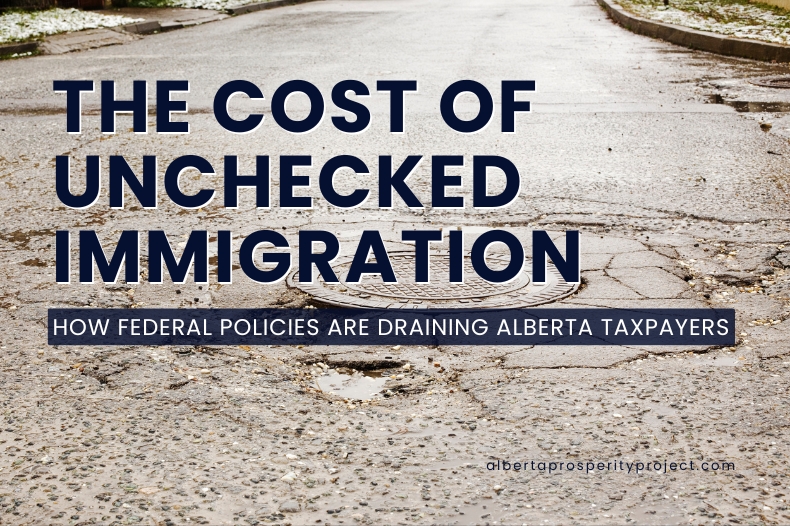By Alberta Prosperity Project
How Federal Policies Are Draining Alberta Taxpayers
In the heart of Canada’s energy powerhouse, Alberta families are grappling with skyrocketing housing prices, overcrowded schools, and wait times for healthcare that stretch into months. While federal politicians in Ottawa tout immigration as an economic boon, a closer look reveals a stark reality: the true cost of supporting newcomers is being shouldered by hardworking Canadians, with Alberta bearing a disproportionate share. As population growth surges, driven by record immigration levels, the fiscal strain on public services is not just a national issue; it’s eroding the prosperity that Albertans have built through resource development and innovation.
Fraser Institute data paints a sobering picture of this fiscal imbalance.
A landmark study revisiting immigration’s impact on Canada’s welfare state found that recent immigrants (those admitted after 1985) imposed a net fiscal burden of $5,329 per capita in 2010, translating to a total annual cost of $27 to $35 billion by 2014. This isn’t ancient history; these figures stem from lower tax contributions relative to benefits received, with recent immigrants paying just 66% of the taxes of other Canadians while drawing on services like healthcare, education, and social supports. Even as per-capita costs dipped slightly due to better selection policies, the sheer volume of arrivals, 260,000 to 285,000 planned for 2015 alone, pushed the absolute burden higher, adding $1.4 to $1.5 billion yearly.
Fast-forward to today, and the problem has intensified. From 2000 to 2024, Canada’s immigrant population exploded, growing at an average annual rate of 15.1% post-2015, with non-permanent residents like temporary workers and international students now comprising a staggering 7.4% of the population. Asia and the Middle East have overtaken traditional sources, shifting demographics and settlement patterns toward urban centers. While economic immigrants make up 58-67% of permanent arrivals, family reunifications and refugees, often with lower initial earnings, add to the fiscal load. In Alberta, where Provincial Nominee Programs have ramped up to fill labour gaps in oil and gas, this means more newcomers relying on provincial services without immediate tax offsets.
The federal government’s 2025-2027 Immigration Levels Plan offers little relief.
Permanent resident targets drop modestly to 395,000 in 2025 (from 464,265 in 2024), stabilizing at under 1% of the population annually by 2028. Temporary residents, however, remain high at 673,650 new arrivals in 2025, with international students alone accounting for 45%. Ottawa acknowledges “capacity for settlement and integration,” citing housing and healthcare pressures, but the plan sidesteps hard numbers on taxpayer costs. This oversight ignores warnings from federal bureaucrats as early as 2022, who flagged that surging immigration would exacerbate housing shortages and service strains.
For Albertans, these national trends hit close to home. The province’s success in attracting migrants, through targeted programs and economic opportunities, has strained systems to the breaking point. A January 2025 analysis by Oxford Economics highlights how rapid population influxes are overwhelming education and healthcare, while driving up housing demand and prices. In Calgary and Edmonton, rental vacancy rates hover near historic lows, with average home prices climbing 5-7% year-over-year despite federal rate cuts. Healthcare wait times, already among Canada’s longest, have worsened; Alberta’s system added over 100,000 new patients in 2024 alone, many recent arrivals, without proportional funding increases.
Economically, the picture costs everyday Albertans.
While high-skilled immigrants in STEM fields can boost productivity and the tax base, the bulk of recent arrivals, lower-skilled temporary workers and students, often face underemployment due to credential barriers and occupational licensing. This drags on per-capita GDP growth, which stagnated at 0.9% from 2016-2019 pre-COVID, and fuels inflation in essentials. A C.D. Howe Institute report warns that high immigration rates reinforce urban-rural divides, benefiting fast-growing cities like Calgary at the expense of slower rural areas, while doing little to address Alberta’s projected labor shortfall of 350,000 workers by 2025. The Fraser Institute’s Federal Blueprint for Prosperity echoes this, linking unplanned population booms to weak labor productivity and a housing crisis that erodes living standards.
Public sentiment has soured accordingly. A September 2025 Environics poll marks the first time in 25 years that a majority of Canadians say there’s “too much” immigration, citing housing woes and service overloads. In Alberta, leaders like Premier Danielle Smith have called for caps, arguing that federal policies ignore provincial realities. As one advocate put it in August 2025, unchecked inflows are “building pressures” that threaten the very economic engine driving Canada’s prosperity.
The Macdonald-Laurier Institute adds a cultural layer, noting that mass immigration, over 5 million since 2014, can import conflicts and erode community cohesion, indirectly hiking costs through social program demands. But the fiscal math is undeniable: without reform, Alberta taxpayers could see billions funneled into supports that outpace contributions.
So, what now?
The Fraser Institute recommends slashing admissions, prioritizing private-sector job offers at average wages, and expanding Provincial Nominee Programs to align with local needs—steps and Independent Alberta could champion. A “Moneyball” approach to selection, favoring high-productivity trades and STEM skills, could turn the tide, as outlined in the Blueprint for Prosperity. Tying targets to housing completions and service capacity would prevent further overload.
Ottawa’s track record shows little hope for meaningful change. It’s time Alberta takes its destiny back into its own hands through independence. By controlling our borders and prioritizing policies that align with our economic strengths, we can protect our prosperity and ensure our families thrive.
Join the movement for a sovereign Alberta at albertaprosperityproject.com, because our future depends on it.
Sources:
https://www.fraserinstitute.org/sites/default/files/immigration-and-the-welfare-state-revisited.pdf
https://www.fraserinstitute.org/sites/default/files/2025-02/federal-blueprint-for-prosperity.pdf
https://www.fraserinstitute.org/categories/immigration
https://www.bbc.com/news/articles/cp9z5rpgkyeo


